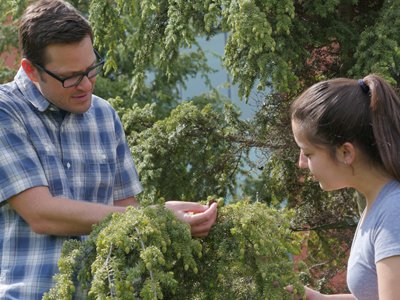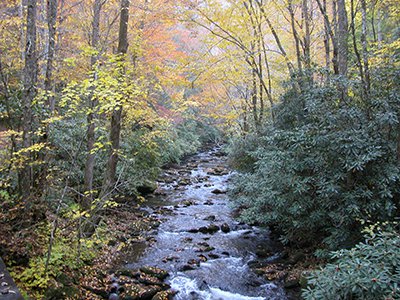Biologist Studies Climate Change in Great Smoky Mountains National Park
"We're trying to define what the future environment will look like in a place like the Smokies that receives more than 10 million visitors a year," says biologist Jason Fridley

Jason Fridley, associate professor of biology in the College of Arts and Sciences, recently received funding from the National Park Service to continue research into the effects of climate change on the forest vegetation and ecosystems of Great Smoky Mountains National Park. In the following, he describes his work and what he hopes to achieve from the findings.
Q. Could you briefly summarize your project? What do you hope to achieve from the research?
Great Smoky Mountains National Park is a unique landscape that protects boreal ('Canadian') forest in the southern U.S. As the climate warms, management is concerned about changes to the colder ecosystems there and whether many of the rare and endangered species of the mountaintops will be 'pushed off' by species that are better adapted to warmer climates. However, in contrast to most other high elevation places—like, say, the high peaks of Colorado—the peaks of the Smokies are essentially a cloud forest, sometimes getting over three meters of rain a year. It's possible that such high rainfall will protect the peaks from warming, because it's difficult to heat up an ecosystem that is saturated with water (not unlike living near the coast in the summertime).
So a big question about the future of the park is whether the high elevations will dry out, and, if they do, how much will they warm? In addition, most of what we know about climate is from weather stations out in the open, not under trees. So there is a great need to take climate predictions down to ground level, beneath the forest canopy—where most of the critters of interest (like salamanders) live. My collaborator at Duke, Ana Barros, is an expert in modeling rainfall at the scale of single mountain passes, so she'll handle the future precipitation part; I'll handle the below-canopy extension, where I've worked in the past using inexpensive temperature sensors that are relatively easy to hide from bears (the main difficulty in doing any fieldwork in the Smokies, other than overall remoteness).
Q. I understand you received funding from the National Park Service; how much did you receive for this research?
It's about $107,000 in 2019 and 2020.

Q. Why is this research important? Why should we care?
Plants like forest trees are at the mercy of their local climate: If it changes, they must adapt, move, or die. The services ecosystems provide are, in turn, dependent on how dominant plants function, whether it be how plants use water that eventually fills our reservoirs (or floods our streets), how plants sequester carbon to prevent additional global warming (like putting carbon in wood or in the soil, where it stays for decades or centuries), or how they absorb chemicals that pollute waterways (for example, nitrates and phosphates that produce algal blooms).
We're trying to determine how large-scale changes in climate impact how ecosystems will change locally, whether that means dead trees, new trees (like invasive species), or no change in some cases due to the ability of some forests to adjust to new climates. On a more conservation level, we're trying to define what the future environment will look like in a place like the Smokies that receives more than 10 million visitors a year—most of whom care at some level about the park's immense diversity of animals and plants, some of which are found nowhere else. Will they have a habitat to live in a few decades from now?
Q. How long have you been interested in this area of research?
Since I was a National Parks Ecological Research Fellow, which was a partnership between the Ecological Society of America and the Mellon Foundation that aimed to get early career ecologists working in the national parks as natural laboratories. It was my first postdoc and a formative experience. The fellowship unfortunately no longer exists, but many of us who got our start with the program are still working in them, despite the limited research funds available to support such activities.
Q. What is the overall timeline for the project?
The planning is underway, including designs for new sensors of tree function that may be able to monitor how an individual tree uses water minute-to-minute. Later in 2018 Ana and I will finish up the design of where the sensors should go, and the fieldwork of deploying the sensors will start in 2019. In 2020 we'll do the bulk of the modeling.
Q. Are any students involved in the research project?
Yes, an MS or PhD student in my lab will lead the field sensor component and then spearhead much of the modeling. I'll recruit this student next year.
Q. In a nutshell, what is your overarching goal of this work?
The ultimate goal is to understand how a changing climate impacts plants and animals that live in highly dissected landscapes. Will some places act as refuges, allowing species to survive in place as the climate warms? If so, where will these places be, and which species may be ‘left out’? The Park Service can then use this information to guide their allocation of limited management resources.
